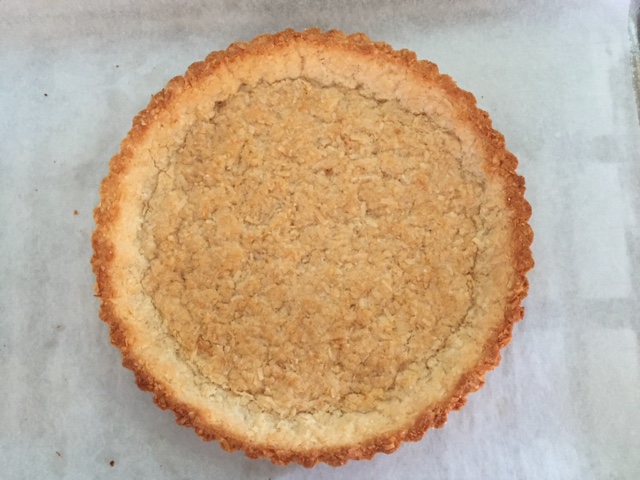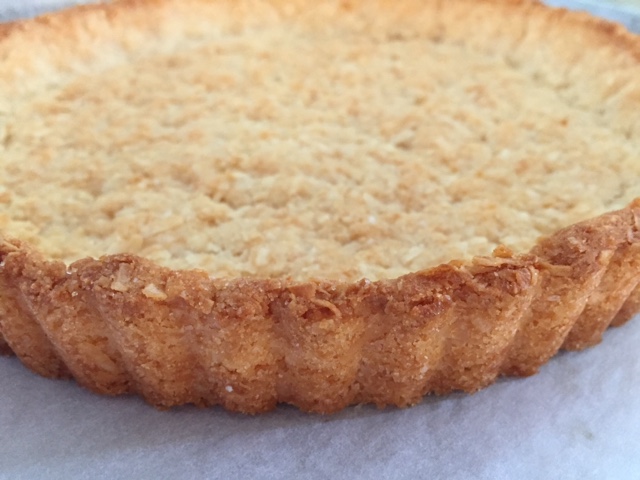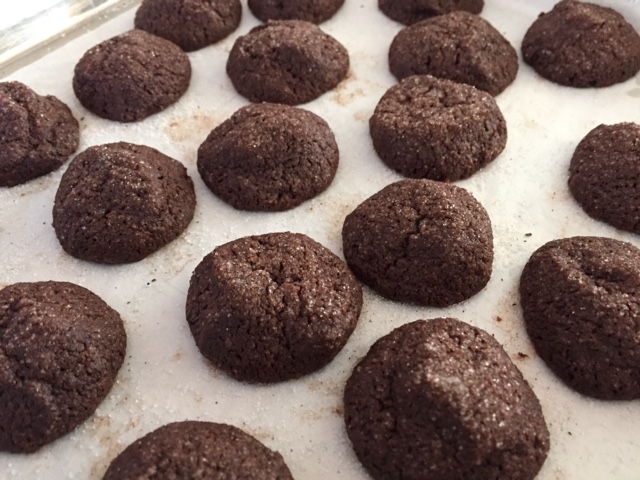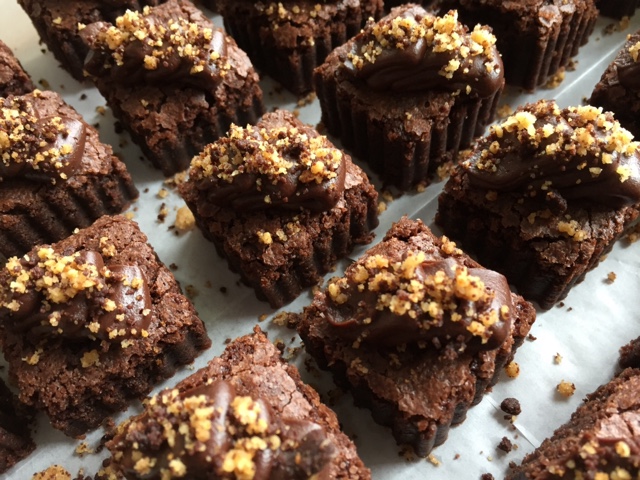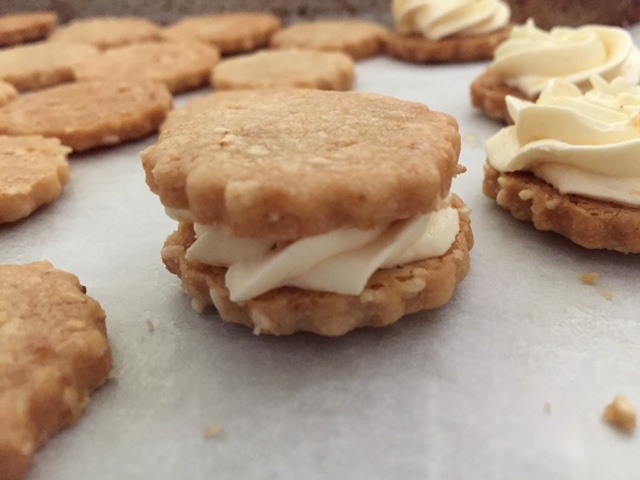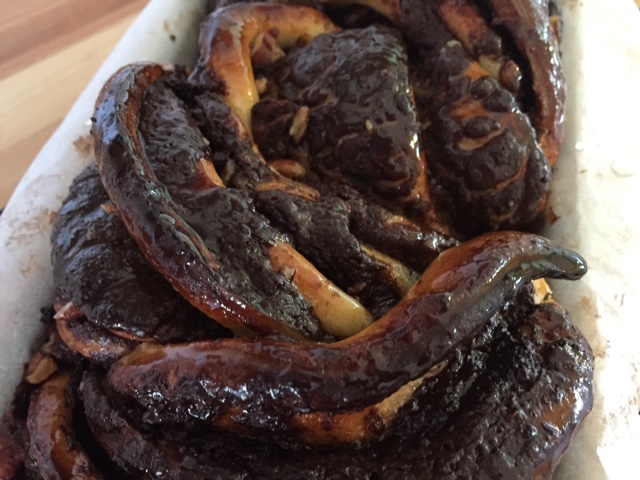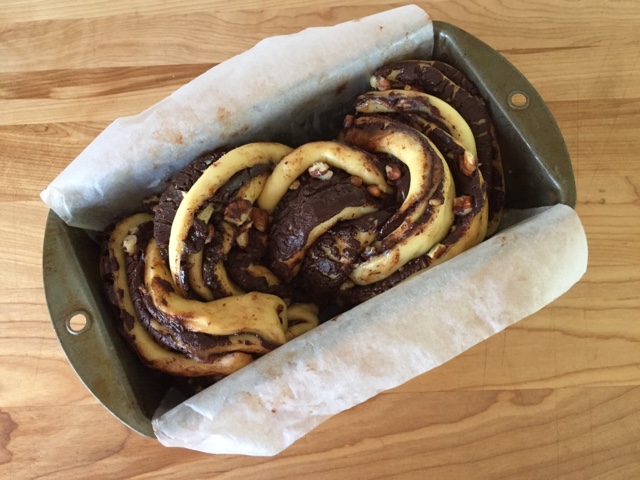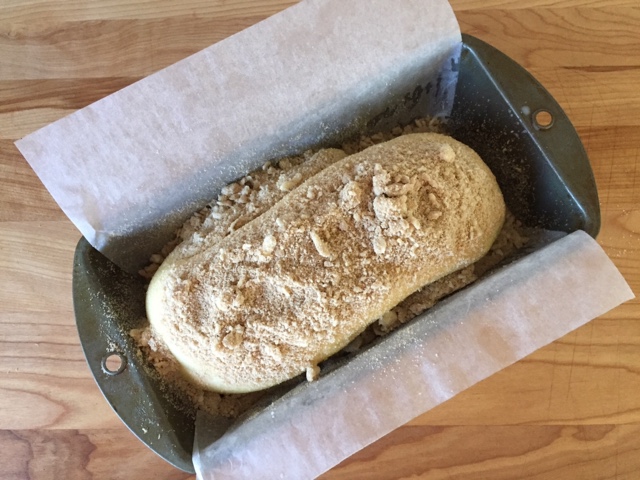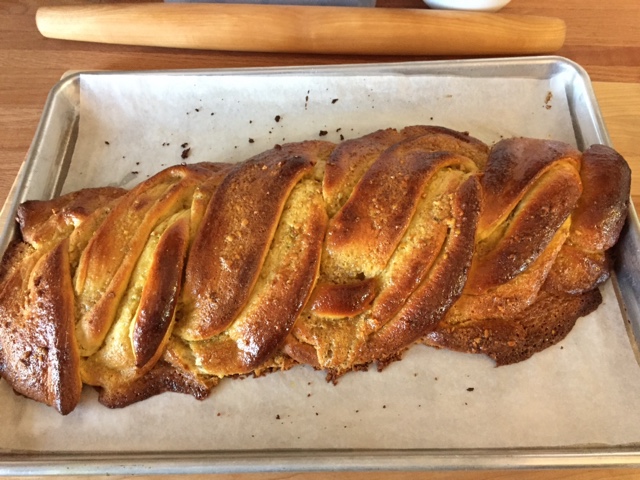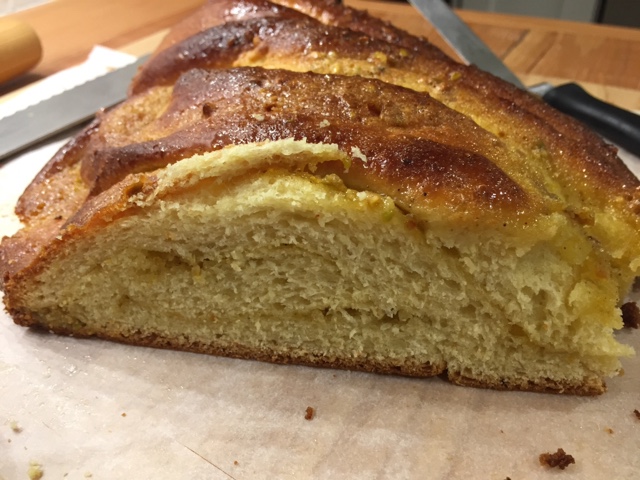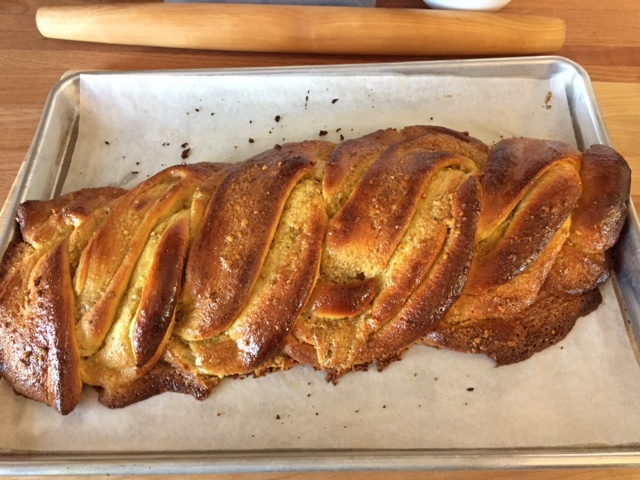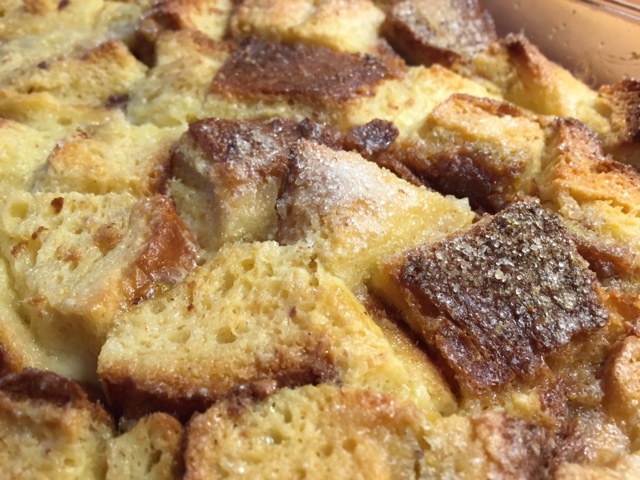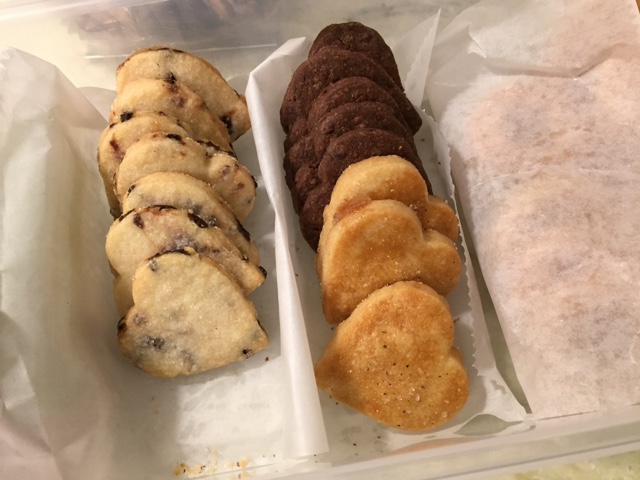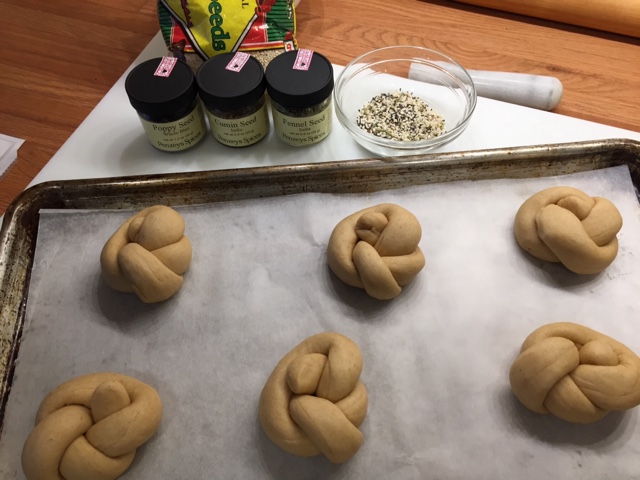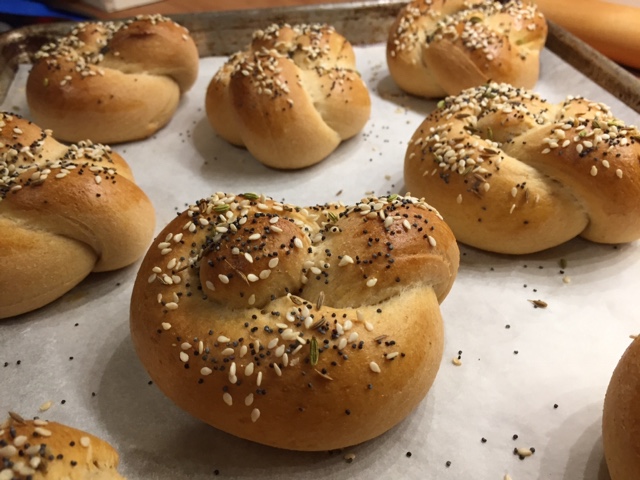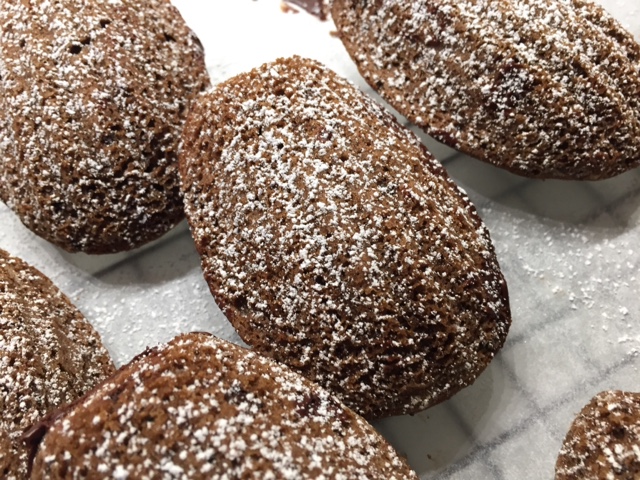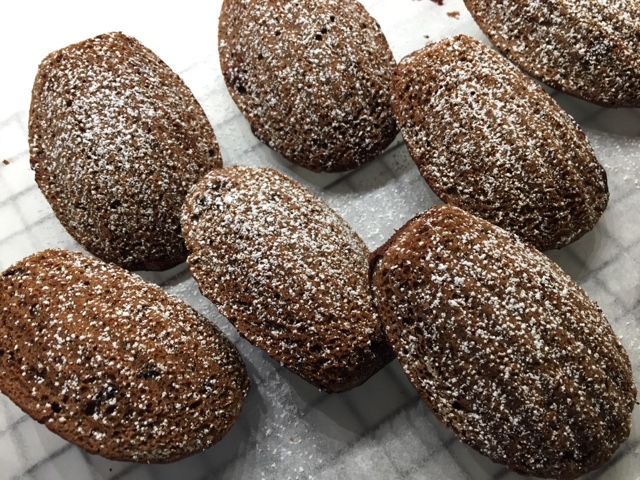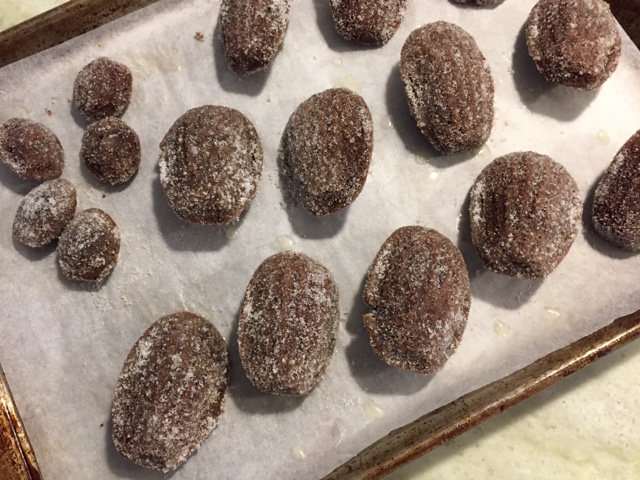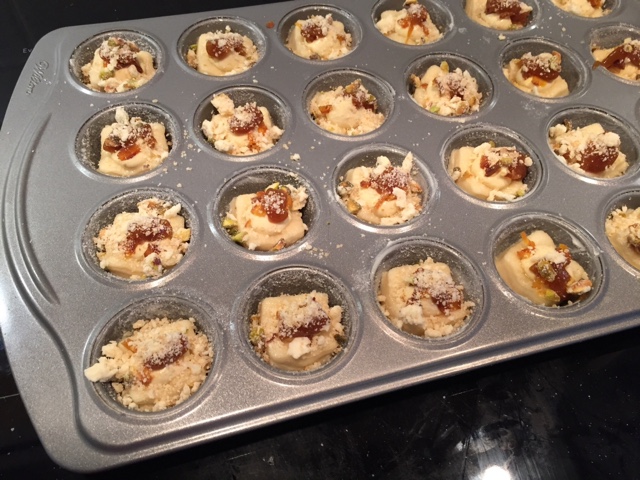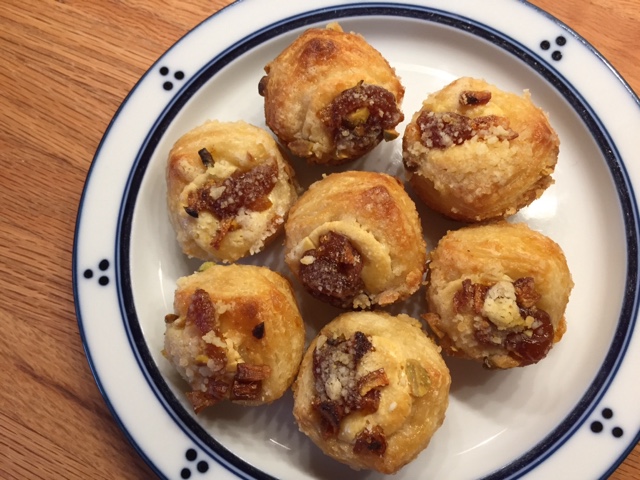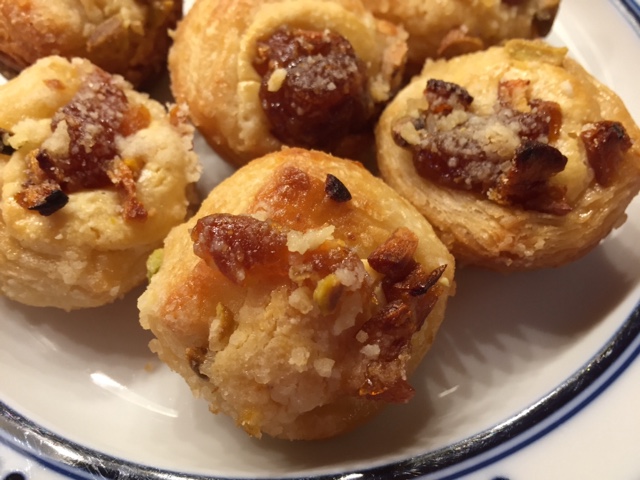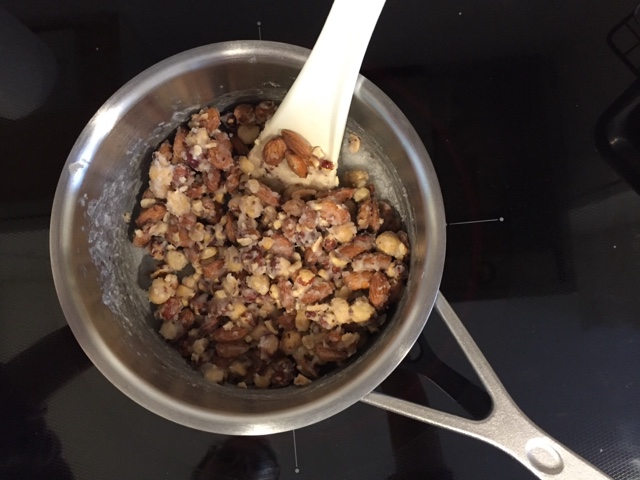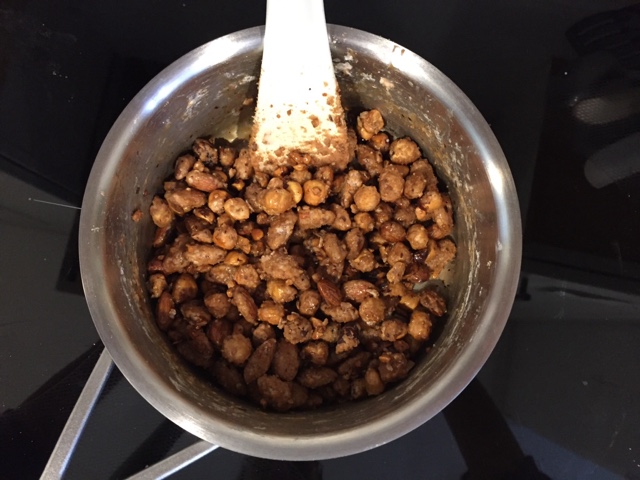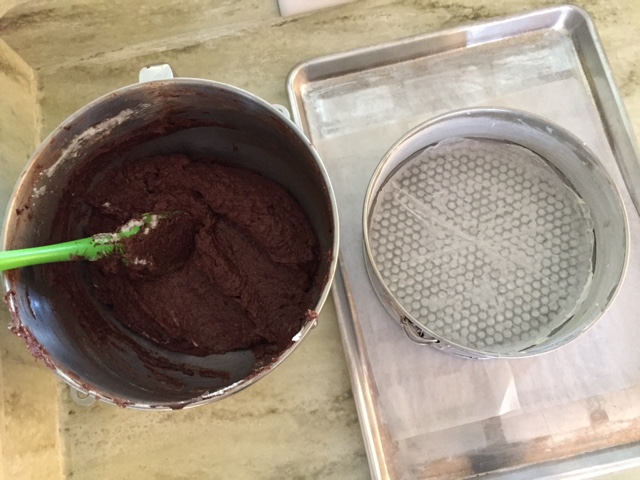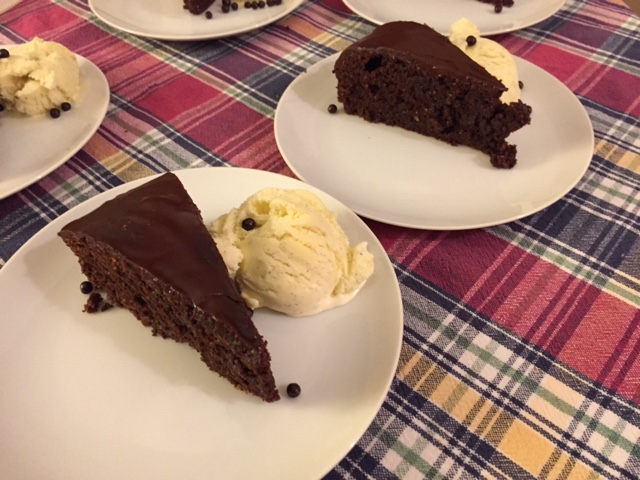Cherry blueberry yogurt cake
/Just a few years apart in age, Mary and I chat away about all manner of things while our mothers talk and talk.
We planned to share afternoon tea with them, so, of course I volunteered to bring something baked to accompany our beverage. Always looking to use up the odd lingering ingredient in the fridge, I decided on a cherry berry cake to which one of said ingredients, yogurt, would be added.
Some years ago I developed a collection of fresh fruit cake recipes that I used to bake at Gerrish's cafe in Winter Harbor ME during my first summer job out of pastry school. They're easy, versatile and allow one to mix and match ingredients and fruits depending on your whims.
Even though we're anticipating the arrival of local Michigan fresh fruits at the farmer's market, we are getting some beautiful Washington state cherries and some decent Georgia blueberries in our go-to Meijer grocery store. So cherry blueberry just had to be the choice!
Here's the recipe, quick and dirty.
Fresh asparagus, Fulton Farmers Market and pizza
/Let's not forget that I do like to wander off into the savory baking realm every now and then, for life is not only about pastry, right? Pizza dough is one of those things I typically have stashed in the freezer for those days when pizza sounds like just the ticket.
First let me mention the dough. Back in 2006 when I was going to Apicius in Florence for my first semester of baking and pastry, Steve and I frequented an English bookstore there. At one of our visits we found a newly released book (I have no idea which one) by Jamie Oliver which was accompanied by a mini-book of sample recipes that was available for purchase. And purchase it we did.
His pizza dough recipe is one I've been using ever since, save for the occasional trial of a new recipe, just to see if I might want to make a change. I always seem to come back to his.
While I typically mix and knead by hand, lately I've taken to using my Kitchenaid stand mixer for the first part of the kneading and finishing it off by hand. LOVE the feel of dough.
Here's the recipe in a nutshell. To 650 ml tepid water add 14 g dry yeast (instant or active dry, either one) and 1 tablespoon sugar, mix with a fork and let sit for a few minutes. Meanwhile place 800 g bread flour and 200 g semolina in a mixing bowl along with 1 tablespoon fine sea salt; give it a quick whisk up with a fork.
Using the dough hook, turn on med-low speed and drizzle the wet ingredients into the dry. Here's where I make my own addition to Jamie's recipe of 2 tablespoon olive oil. Knead on med-low speed for about 4-5 minutes then turn the dough out onto a lightly floured surface and continue kneading for another few minutes to achieve a soft, springy dough.
Cover with cling film and let rest about 20-30 minutes at room temperature. I divide the dough into six 283 g (10 ounce) pieces, wrap them individually, pop 'em into a zip-top bag and freeze.
If using the dough immediately, roll it out on a lightly floured surface, place on your oiled sheet pan (or baking stone or baking steel or whatever you're using), top with your favorite pizza goodies and pop into a 500º oven.
Pizza is one of our favorite ways to use up fridge left overs like grilled chicken or pork (thinly sliced for pizza purposes) and chunked up roasted potatoes. We generally add in some fresh veggies like tomatoes and shaved broccoli followed by a topping of grated cheese.
This time - fresh asparagus. Yippee!
It was a simple matter of cutting the lovely green stalks into shorter pieces, peeling and slicing the stems in half and throwing them into the mix. No blanching ahead of time, just freshly cut and trimmed.
I've been using a good old 1/2 sheet pan for a long time - olive-oiled and dusted with semolina, then into a 500º oven for about 13-15 minutes. Et voila!
Some new flour ingredients
/First off - coconut flour.
Now here's where I leave the filling up to you.
New York style bagels
/ |
| after the rise |
A tasty trio for spring
/And now on to the baking portion of the program.
The brownie bites were the recipe I've been making for Steve for some years, based on one from Fine Cooking magazine by Abigail Johnson way back when. I gave them a ganache ribbon topping and sprinkled my chocolate-graham crumb- walnut crumble mixture on top. Yup.
Easter desserts, happy spring and one more chocolate babka
/Babka trial Part 3 - another chocolate pecan
/The snail coil received its wash and streusel.
I baked the plait for 45-50 minutes at 350º convection. I attempted to check an internal dough temperature which reached over 185º but couldn't be sure if my temperature probe was in dough or chocolate. When tapping the dough on the surface, it had a nice thump, and my inserted skewer came out clean. Out of the oven it came.
I baked the snail for the same amount of time and took it out after a resounding thump was heard when tapping the top and a 185º internal temperature was reached.
Babka trial Part 2 - chocolate pecan
/While the dough was warming up a bit I made the chocolate filling by melting 100 g unsalted butter in a saucepan, adding 150 g granulated sugar and blending to (mostly) dissolve the sugar. Off the heat I added 85 g chopped chocolate (70%), stirred to melt, then blended in 40 g Dutch process cocoa powder and a teaspoon of Vietnamese cinnamon.
This time I worked a bit harder at rolling a tight log.
Then I sliced it lengthwise down the middle and formed my braid. Whew! That went pretty well.
Will this turn out??!! Seems like a good deal of weight that has to poof up, n'est-ce pas?
Once out of the oven I brushed it all over with simple syrup which I had made a bit earlier with 100 g sugar, 125 g water and one tablespoon honey brought to a boil, boiled for about 4 minutes, then set aside to cool to room temperature.
Pistachio babka trial and a tasty bread pudding
/Cream 6 tablespoons/85 g unsalted butter (melted or soft room temp) with 6 tablespoons/85 g sugar on medium speed for 1-2 minutes.
Add 1 teaspoon vanilla extract to 4 egg yolks, add to the sugar mixture in 4 additions and mix on medium-high for a couple of minutes.
Stop the mixer, add 3 1/3 cups/425 g all purpose flour and one teaspoon salt then the milk/yeast mixture. Mix on low for 2-3 minutes to achieve a soft, supple, tacky dough.
Now you can either move on to the shaping step or place the dough in the fridge (covered) overnight to be rolled out the next day.
I placed it on a tray in the freezer for about 10 minutes, hoping that the filling would tighten up a bit. I was already envisioning the pistachio goodness oozing out as soon as I sliced my log lengthwise. I was going for a free form twisted loaf rather than putting the braid into a loaf pan as many babka recipes suggest.
I gently and gingerly twisted the two pieces around each other, attempting to keep the cut sides up.
After some cooling I sliced into this interesting piece and found that my layers were pretty much non-existent. As I suspected, a lot of the pistachio filling had oozed out during baking.
I sprinkled some coarse sugar and freshly grated a bit of nutmeg on the top, then baked the pudding in a 350º oven for about 45 minutes until set.
Happy Valentine's Day!
/ |
| Chocolate hazelnut financier |
Once these little cakes are turned out of the mold, there's a wonderful well just waiting to be filled with something delicious.
 |
| Praliné ganache and candied hazelnut garnish |
Sweets for the sweet. Happy Valentine's Day to one and all!
Enjoy.
Seeded knot rolls
/45g/3 tablespoons sugar
7g/1.25 teaspoons salt
7g/2 teaspoons instant yeast
Combine all the ingredients in the bowl of a stand mixer fitted with the dough hook. Mix on low to moisten all the ingredients until the dough starts to pull together. Then knead on low for about 5-6 minutes to achieve a smooth and supple dough.
Place the dough into a lightly oiled bowl, cover it and let rise for about an hour at room temperature.
Place the dough on a lightly oiled surface. In my case I divided my double batch of dough in half and shaped one half into an 8 inch log which I then placed in a lightly oiled 8 1/2" x 4 1/2" loaf pan. Cover with lightly oiled plastic wrap and allow it to rise about 60 minutes (or longer if you're working in a cool kitchen). The dough should crown about 1 inch above the pan rim.
The second half of dough was destined to become knot rolls. Oh boy!
Working on a lightly oiled surface, I divided the dough into nine 85 g/3 oz pieces. I rolled each piece into a snake-like ~12" length and formed each into a knot. Cool! It's all about tucking the ends just so.
Into the oven they go!
There's nothing like a freshly baked warm roll with a bit of thinly spread butter. You can't beat it.
Chocolate madeleines and more than you'll ever want to know about making them
/I reacted to my first taste of a mini with the feeling that the chocolate flavor wasn't as forward as I would have liked. However, the texture was sooooo light and ethereal - I've never had a madeleine like it! As I continued to sample a few more, they grew on me. Steve too.
With another bunch of the finished cakes, at Steve's suggestion, I did what I used to do with the little coriander buttermilk cakes I used to make in Rhode Island. I re-warmed the madeleines briefly in the oven then dipped them in melted butter and rolled them in coriander sugar.
Dried apricot purée and something new with croissant dough
/First the purée. After some recipe research I came up with a pretty straight forward approach involving poaching the dried apricots in a light sugar syrup with added orange zest. Apricots go soooo nicely with orange, n'est pas?
I decided to freeze the end result by portioning it out into an ice cube tray. That allowed me to remove small amounts on an as needed basis. Interestingly the purée didn't freeze solid due to the sugar content but it was a good way to store it nonetheless.
And Steve liked them too. Yippee!
Praliné et sablés
/There is an ingredient in the pastry world called praliné which consists of toasted nuts coated in caramel that are then cooled and ground into a paste. It is often made with hazelnuts or a 50/50 mix of almonds and hazelnuts, although any nut (nuts in general are referred to as fruits sec, en français) or combination thereof can work.
One of the first sets of recipes we were given in the basic pastry course at Le Cordon Bleu contained a recipe for do-it-yourself praliné or praline paste. One can buy this particular delight ready made in fairly pricey tubs from companies like Valrhona, but I thought it was high time I made it myself. Why not?!
What inspired me to take on this project was a recipe for sablés au praliné from Thierry Mulhaupt (a well known patissier chocolatier in the Alsace region) recently published on the French blog La Cuisine de Mercotte. The recipe for les sablés contains a link for DIY le praliné and I went for it!
Turn them out of the pan onto a Silpat, spreading them into a single layer and separating the nuts as much as possible.
This stuff will keep in a covered container at room temperature for several weeks.
Next comes the cookie dough.
Dice 300 g cold butter and sand it into a mixture of 300 g all purpose flour, 65 g almond flour and 65 g powdered sugar. Add 175 g praliné and a large pinch of fleur de sel and blend to create a smooth dough.
Chocolate hazelnut torte
/Pistachio berry dacquoise
/
I'm a bit behind the curve on this one but welcome to 2017!
During the Christmas-New Year's week we had a lovely dinner at friend Margaret's cozy and festively decorated home. She rustled up a Viennese beef stew with noodles, as a reminder of her recent trip to Austria in early December. Her friend Kate brought a delicious and full-of-good-stuff green salad, and I, of course, brought dessert.
Creamy custard, lightly sweetened berry compote, candied pistachios - all nestled on a dacquoise base. Sounds pretty good!
Dacquoise is one of my favorite things to make (and to eat, yes sir!). It's basically a soft nut meringue with the same ingredients as the popular and trendy French macaron, but it is WAY less fussy and tastes great too.
Having egg whites in the fridge is often the impetus I need to make dacquoise, and so it was that I began to imagine a pistachio version for my dessert creation.
The recipe (this is half my typical base recipe): in a separate bowl whisk together 50 g almond flour, 50 g ground unsalted raw pistachios and 75 g confectioners sugar. In a mixer with the whisk attachment whip 3 egg whites with 25 g granulated sugar to stiff peaks. Gently fold in the nut/confectioners sugar mixture just until blended.
NOTE: you can use any ground nut, either by itself or as a mix - almond, pistachio, hazelnut, walnut or pecan - you decide.
Once the dacquoise is mixed you can pipe any shape you choose, depending on your dessert vision. You can see what I did below. I think of these as dacquoise rafts just waiting to float down a dessert river, and, in this case, destined to carry a creamy ricotta custard ingot.

ready for the oven

all baked up!
Dacquoise is one of the few things for which I use silicone baking mats. The softly baked meringue lifts off the Silpat so easily. It's a beautiful thing. And another plus is you can make these ahead and freeze them until ready to go.
Candied pistachios are next. Adjust the recipe depending on the quantities you need, but a typical base recipe calls for 2 cups raw nuts, about 1/2 an egg white, some sugar as well as spices of choice if that's what you're after - cinnamon, nutmeg, ginger, coriander, even a little cayenne pepper - it's up to you.
Just whisk up the egg white until foamy, whisk in about 1/4 cup sugar (and the optional spices) then stir in the nuts until coated. Spread out onto a parchment or Silpat lined pan and bake at 325ºF, stirring every 10 minutes or so, until the egg whites have dried and things look toasty. It usually takes about 20-25 minutes for me.
Good news - the nuts are another do-ahead component that will keep at room temperature in a covered container for many days.

crunchy goodness
The beauty of these is they aren't really very sweet, even though coated in sugar - just deliciously enjoyable!
The ricotta custard is a combo of 177 g ricotta, 354 g cream cheese, 112 g sugar, 2 eggs, 1 egg white, seeds from 1/2 scraped vanilla bean and 177 g heavy cream. Beat the cheeses, sugar, vanilla bean in the mixer until smooth, beat in the egg and white, then add the cream and blend.
Pour the custard into flexible silicone molds of choice. I used Silikomart's SF026 12-well ingot shaped mold.
Place the molds on a sheet pan, pour some hot water in to bathe the lower half of the molds and bake at 275ºF until the custard is set. The time will vary depending on the size of your molds (for these it took 20-25 minutes). This recipe made about 20 custard ingots.
Once baked, let the custards cool to room temperature then put them, mold and all, into the freezer until firm. Then you can pop them out of the molds and store them frozen. Yay! Another do-ahead.
In the afternoon on your designated dessert day, just place the frozen shapes onto your chosen bases and refrigerate to thaw before serving. The custards hold their shape and are ready to garnish and enjoy!
I made a berry compote with a mixture of raspberries and blackberries (total 300 g) in a saucepan with 40 g of sugar and some lime zest. Heat 'em up until the berries break down a bit then stir in a cornstarch slurry (2 teaspoons cornstarch whisked in 1 tablespoon warm water) and simmer a few minutes until the mixture thickens.
Serve it a bit on the warm side or refrigerate it until ready to use. By now you know - do-ahead!!

What a luscious combination enjoyed by all! And a simple vanilla shortbread on the side added that extra special something.
Happy New Year from The French Tarte. Here's to all the baking and dessert creations to come!
Beer bread
/For the dish he searched out the availability of Belgian beer here in Grand Rapids and came up with a dark Belgian style Canadian beer from Martha's Vineyard, a fantastic local purveyor of all things culinary, including a vast selection of wine and beer from far and wide.
Since Steve didn't use the entire 750 ml bottle of beer for the carbonnade, I decided to finish it off by making beer bread. So, of course, I turned to Rose Levy Beranbaum's The Bread Bible.
What a straight forward recipe! Easy to mix up, whether by hand or in the mixer, soft and supple and carrying the aroma of yeasty beer.
Apricot orange cake with pistachio crumble
/
How often do you buy an ingredient with a specific project in mind, only to have that ingredient languish on the shelf or in the fridge waiting to be used? Fortunately, that doesn't happen too frequently, but, every now and then it's a good idea to see what's on hand, both in the fridge and the freezer, and figure out ways to use up things that are either nearing the end of their shelf life or are begging to be baked into something delicious.
This time - dried apricots and yogurt with unbaked pistachio crumble on the side.

Here I opted for a loaf cake variation on a recipe for orange currant muffins with pistachio crumb which I've had in my files for some time now. I’m not even sure where I found it. I used yogurt instead of sour cream and diced dried apricots for currants. Here goes! It's a straight forward batter.
Get the printable PDF recipe here!
Heat the oven to 325ºF. Butter a medium loaf pan, line it with parchment and butter the parchment as well.
In a separate bowl whisk together 195 g / 1.5 cups all purpose flour, 1.5 teaspoons baking powder, 1/4 teaspoon baking soda and 1/4 teaspoon salt. OPT: replace 1/3 of the flour with white whole wheat or spelt.
In the bowl of a stand mixer fitted with the paddle, cream 70 g / 5 TBSP unsalted butter with 1/2 cup / 100 g sugar (white or brown) until light and fluffy; blend in 1 large egg; blend in 3/4 cup full fat plain yogurt and orange zest from one medium orange.
Add the dry ingredients and mix just until incorporated; fold in 1/2 cup diced dried apricots. The batter will be thick.
Spread the batter in the prepared pan.
Top with a healthy layer of pistachio crumble made by combining 65 g / 1/2 cup flour, 50 g / 1/4 cup sugar (white or brown) in a medium bowl, then sanding in 56 g / 2 ounces cold, diced unsalted butter to coarse crumbs; add 30 g chopped pistachios. Easily double or triple the quantities and make plenty for freezer extras.

Bake for approximately 45 minutes until the top is browned and a skewer inserted in the center comes out clean.
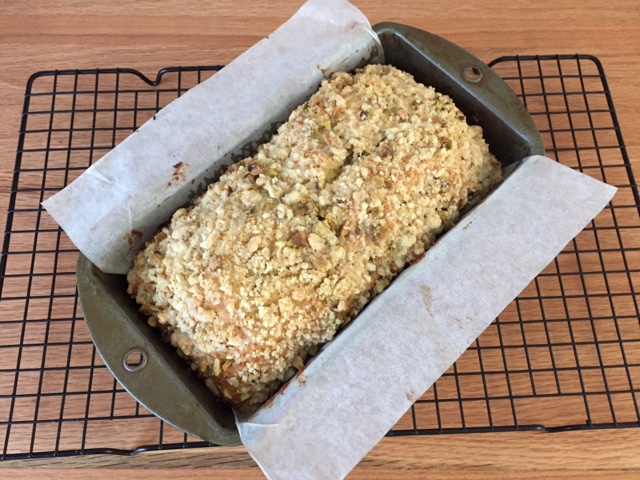
After about 10 minutes lift the cake out and let cool.

Slice and enjoy!
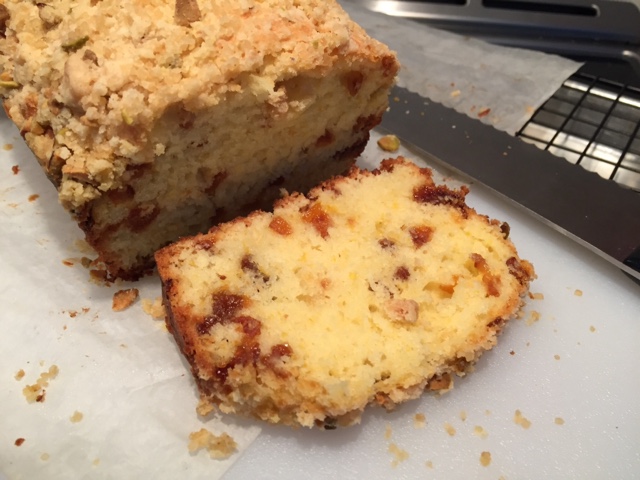
I simply couldn't wait until this had completely cooled. The still warm, fruit studded, moist, pistachio crumbly and oh-so-delicious slice was just the thing for a middle-of-a-winter-afternoon snack.
And guess what - Steve liked it too!!

























